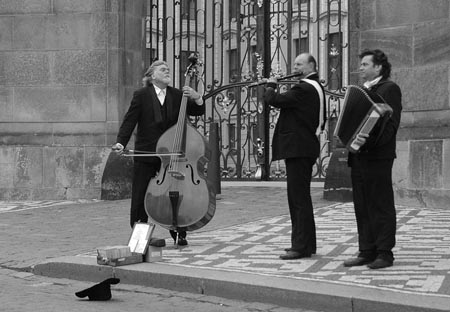
Jazz Trio and Dialogue
Let’s remember two things about dialogue:
-It’s not the same as conversation in real life. It’s a construct. A thing we build.
-Its purpose is not to move plot along. “Do you want a glass of lemonade?” “Sure, I want a glass of lemonade.” This is horrible.
The purpose of dialogue is to reveal character. The personality, concerns, wounds, aspirations, varying moods of each speaker. And to reveal the nature of the relationships between characters.
If we use dialogue to push the plot along, we make is noise. If our dialogue reveals character, we make music!
This image, “Street Musicians in Prague” was shot by Keith Page. Imagine you’re walking around Prague. You come upon street musicians and stop. The accordion player looks at the bassist and the flute player in the middle is aware of his friends on either side. They’re speaking and listening to each other and you realize this is the essence of dialogue.
You close your eyes to get closer to the sound, to learn from it. What happens?
Effortlessly, you hear each instrument. You track how the focus in the music moves from the bass to the accordion to the flute. Sometimes all three play at once, sometimes two. In all those configurations, you’re able to easily recognize each instrument, even with your eyes closed. Nobody has to stand next to the musicians on the sidewalk and announce, “Here comes the flute!” because each instrument sounds entirely unlike the others, even when they all three play the same note. And this will always be true. No matter what music they play.
We want our characters to possess this same uniqueness. To be recognizable when they speak. To have dialogue that needs no attribution. No “he said,” and “she said.” This is true no matter what form our story takes: memoir, flash, historical fiction, sci-fi.
To achieve this, we can do many things. Vary the vocabulary of each character. One has pet phrases or a kind of slang. Another, swearing. Jokes.
Vary their behavior. One always interrupts. Another says almost nothing in words but lots in gesture and action. One is ribald and uses innuendo, another self-corrects and is always subtly judgmental. The length of their sentences can vary. Their tendency to be verbose or compact, loud or soft, gentle or harsh, repetitive or lean.
And then, vary their sound depending on the scene. Like musicians who achieve from one instrument sound that is loud, soft, rapid, slow, staccato or languid.
We can do a great deal to differentiate our characters in the dialogue we create.
And, last, let us not forget that in every single kind of music there silence matters. The composer and the performer fashion the silences as much as the sound, and on the page, we can too. And we should.
To me, silence is the very most important aspect of ALL music. In our dialogue and our stories as a whole, our poems, memoirs, novels, we can and should let silence have its voice. We should orchestrate it. The pause. The hesitation. The walking out of the room that ends an angry conversation with nothing said. To create that hanging- in- the- air feeling for the reader. Or to create the reverential silence that happens when the character feels awe or wonder or gratitude and there are no adequate words. We find silence in the white of the blank page. We should orchestrate this as well. Silence and sound, white and ink.
Exercises:
1. Listen to some instrumental music you like. Ask yourself:
-Can I tell which instruments are playing? When one is solo, can I tell which one? Write a scene with my character at a party. Can I hear my own character’s voice distinct from the others?
-Does one instrument take a phrase played earlier by another? Imagine my character repeating something said earlier by another character. Write the scene. Is the phrase accurately repeated? Deliberately altered? Is it part of an argument? A joke? A mocking? Is it repeated reverently? What does this repeat reveal about their relationship?
–Does one instrument ask a question and another answer it? Write a question my character asks at the start of my story and write the answer given much later.
-Can I hear the silence in this music I like? When I examine my dialogue sections, have I utilized the power of silence to enrich the scene?
2.Take a piece of your dialogue. Cover the attributions (“he said,” and “she said”).
– Would a reader be able to tell who’s speaking?
-Does the dialogue advance plot or reveal character?
3.Walk around. Listen to music you encounter. A saxophonist near muni, music piped into a café, a church service you drop into at noon, booming music from a passing car. Pick one. Is the sound soft, bombastic, playful, mournful? Who’s speaking? Who’s listening? Is it interior monologue? Write the scene.
-Put yourself back in those moments when the music in your surroundings made you pause to listen. Ask yourself, does this new piece of dialogue I’ve just written sound like music? Have I made this piece of dialogue into art?
Contact maryrakow1@gmail.com
©Mary Rakow, 2023. Please do not reproduce without written permission from the author.